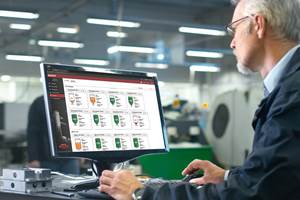Getting Control of Materials Handling
“It has made my life a whole lot easier,” says Steve Holdren, technical manager. “It’s a night-and day difference,” agrees maintenance manager Matt Dzambazi.
“It has made my life a whole lot easier,” says Steve Holdren, technical manager. “It’s a night-and day difference,” agrees maintenance manager Matt Dzambazi. Until last year, materials handling was a major headache for Rexam Home & Personal Care in Buffalo Grove, Ill. The problem lay in the PLC control system for automated material delivery to 40 injection presses in the main molding room. Installed when the plant was built in 1995, the system just kept shutting itself down. “The old wiring and control system was very susceptible to static charges and radio-frequency interference in the plant,” recalls Holdren. “Circuit boards kept going out. Often one control problem would shut down a whole row of presses—half the room. Every week we had problems. In one three-month span, we had daily shutdowns.”
“The system was very hard to troubleshoot. We got a numerical error message on a little 2 x 2 in. screen, but it required an experienced person to scroll through lines of code to find out what the problem was and where.”
THE DIFFERENCE A PC MAKES
Last year, Rexam upgraded the Buffalo Grove plant, which produces containers and closures for home and personal-care products. It runs 24/7 with 57 presses from 165 to 750 tons. Rexam rewired the material-handling system and installed a Factory Acquisition Control System (F.A.C.S.) from Universal Dynamics, Inc., Woodbridge, Va. That system uses a PC interface to a PLC controller, plus low-voltage, twisted-pair wiring that costs much less to install than with the old PLC system.
The new system has proved far more reliable than the old. “Downtime problems are one-tenth of what we had before,” says Holdren. “Now, they are mainly cases of human error, like if a material handler leaves a hose off a resin line.” Press availability rose to around 87% from 70-75% before.
The PC-based F.A.C.S. system has a large screen that communicates immediately where the problem occurred and the nature of the problem in plain English (e.g., “Material level low”). Says Holdren, “Now, if I have to fix something, I know which machine it is and what I have to do.” The screen also color-codes the pumps: Green means a pump has material; yellow means the level in the silo or surge bin is getting low; and red says material has run out. “Before, a major cause of downtime was running out of material. And we could not quickly find out where the alarm was coming from. Now we know where the level is getting low before we run out.”
Holdren divided the main molding room into six separate cells, each with a resin conveying pump and six or seven machines. Although one F.A.C.S. system can handle 132 machines, Holdren bought one F.A.C.S. system for each cell. Although this was admittedly overkill, he wanted extra security. With separate control systems, any problem would be limited to one cell. The extra cost was minimal, he said, for additional PCs and copies of the UnaDyn software.
Holdren installed a large sign in the molding room with six color-coded lights. If there is a malfunction, he can tell at a glance which cell is affected, and he can go to the F.A.C.S. screen for that cell to pinpoint the problem.
NEXT: MATERIAL CONTROL
Rexam is expanding F.A.C.S. material-handling control from just the main molding room to the rest of the plant. And in the main room, Holdren is making use of more of the system’s capabilities by hooking it up to the Maguire gravimetric blenders on all the presses. “Materials are our biggest cost,” Holdren explains. The plant runs over 40 million lb/yr, mostly PP. “The F.A.C.S. will show us our usage of resin, regrind, color, and additives. We’ll be able to compare that to production records to know if we are making overweight parts or losing material to scrap.” Holdren adds, “It will also add safety, since we’ll be able to set blend ratios from the F.A.C.S. screen without climbing up on the machine to get to the blender controls.”
Related Content
PiovanGroup Rebrands, with Mostly Minor Name Changes
For the most part, subsidiary company names will remain, with slight modifications meant to enhance the Group’s identity.
Read More‘Digitalization’ – Awkward Term for a Vital Concept
At K 2022, 85 machines from 40 companies showed off their Industry 4.0 capabilities via OPC-UA interface. A new universal interface for Material Supply Systems was revealed at the show.
Read MoreSingle View of Bin & Silo Material Levels in Multiple Locations
Got a bin in Buffalo and a silo in San José? BinMaster’s latest addition to its cloud inventory software lets you see all your resin inventory anywhere in one view.
Read MoreConair Names New Execs in Sales, Systems, Product Management and Extrusion
Moves aimed at strengthening customer focus, market awareness, and technical expertise in key areas of our business.
Read MoreRead Next
People 4.0 – How to Get Buy-In from Your Staff for Industry 4.0 Systems
Implementing a production monitoring system as the foundation of a ‘smart factory’ is about integrating people with new technology as much as it is about integrating machines and computers. Here are tips from a company that has gone through the process.
Read MoreProcessor Turns to AI to Help Keep Machines Humming
At captive processor McConkey, a new generation of artificial intelligence models, highlighted by ChatGPT, is helping it wade through the shortage of skilled labor and keep its production lines churning out good parts.
Read MoreTroubleshooting Screw and Barrel Wear in Extrusion
Extruder screws and barrels will wear over time. If you are seeing a reduction in specific rate and higher discharge temperatures, wear is the likely culprit.
Read More










